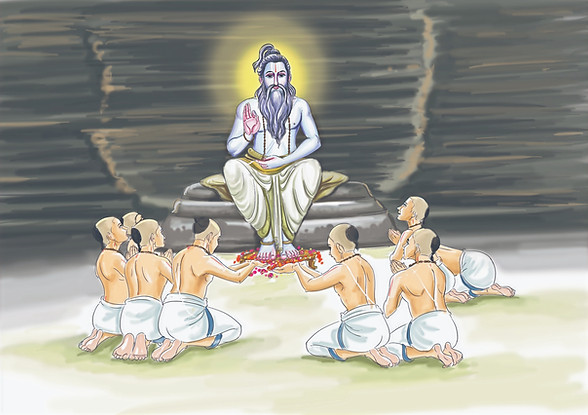

Contributions of Sri Veda Vyasa - The Ancient Sage Who Organized Knowledge for Humanity
Contributions of Sri Ve:da Vya:sa -
The Ancient Sage Who Organized Knowledge for Humanity

Imagine a world where all knowledge was a vast, unorganized ocean. It would be incredibly difficult to navigate, wouldn't it? Thousands of years ago, a brilliant sage named Ve:da Vya:sa faced a similar challenge with the ancient Vedic scriptures. He wasn't just a scholar; he was a visionary who dedicated his life to making profound wisdom understandable and accessible to everyone.
Organizing the Universe of Knowledge
Originally, the Ve:das were a single, immense body of knowledge. Ve:da Vya:sa, took on the monumental task of dividing this vast text into four distinct parts. Each of these four Ve:das focused on different aspects of life and wisdom:
-
Rituals (Yajnas): Guiding people through sacred ceremonies and practices.
-
Principles: Exploring the fundamental truths of existence.
-
Dharma: Laying out the principles of righteous conduct and duty.
-
Medicine: Offering insights into healing and well-being.
-
Arts: Delving into practices that bring joy and connect with various deities.
Beyond just organizing, Vya:sa also deeply understood the essence of the Upanishads and Ve:da:nta:s. These philosophical texts explain the nature of the Supreme Being (Parama:tma) and the intricate relationship between individual souls (Ji:va:tmas), nature (Prakruthi), and the divine. To make these complex ideas easier to grasp, he authored the Brahma Su:tra:s, a concise summary of these profound teachings.
Stories, Devotion, and the Path to Wisdom
Ve:da Vya:sa knew that not everyone learns through dense philosophical texts. He believed in the power of stories and relatable narratives. That's why he wrote the 18 Pura:na:s, which conveyed spiritual teachings through engaging discourses and tales. These Pura:na:s illuminated different paths to spiritual growth:
-
Karma: The path of action and righteous deeds.
-
Devotion (Bhakti): The path of love and surrender to the divine.
-
Knowledge (Jna:na): The path of wisdom and understanding.
Perhaps his most famous work, the Maha:bha:rata, was specifically created to help ordinary people understand higher knowledge and dharma in a simple, accessible way. It's a vast epic filled with characters, conflicts, and lessons that resonate even today.
The Missing Piece: The Power of Devotion
Despite all these incredible works, Vya:sa felt a sense of incompleteness. It was the wise sage Na:rada who pointed out what was missing: a deeper emphasis on devotion (Bhakti) and complete surrender (Sarana:gati) to the Supreme Being.
Taking Na:rada's advice, Ve:da Vya:sa then authored the Srimad Bha:gavatam, also known as the Moksha Sha:stra (the scripture of liberation). This beautiful work filled the gap, providing a profound guide to the path of unwavering devotion and surrender, ultimately leading to spiritual freedom.
Ve:da Vya:sa's legacy is immense. He didn't just write books; he organized, simplified, and presented profound spiritual knowledge in ways that have guided countless generations. His dedication ensures that the timeless wisdom of the Ve:das remains a beacon for all who seek understanding and a deeper connection to the divine. He is aptly venerated as Sri Ve:da Vya:sa “Bhagawa:n”!

JAI SRIMANNARAYANA!
